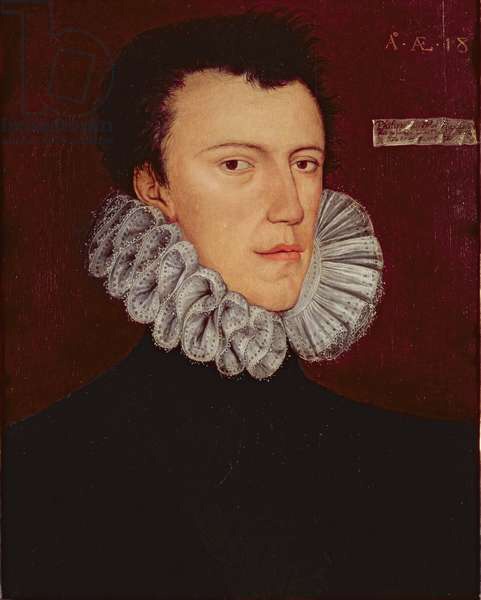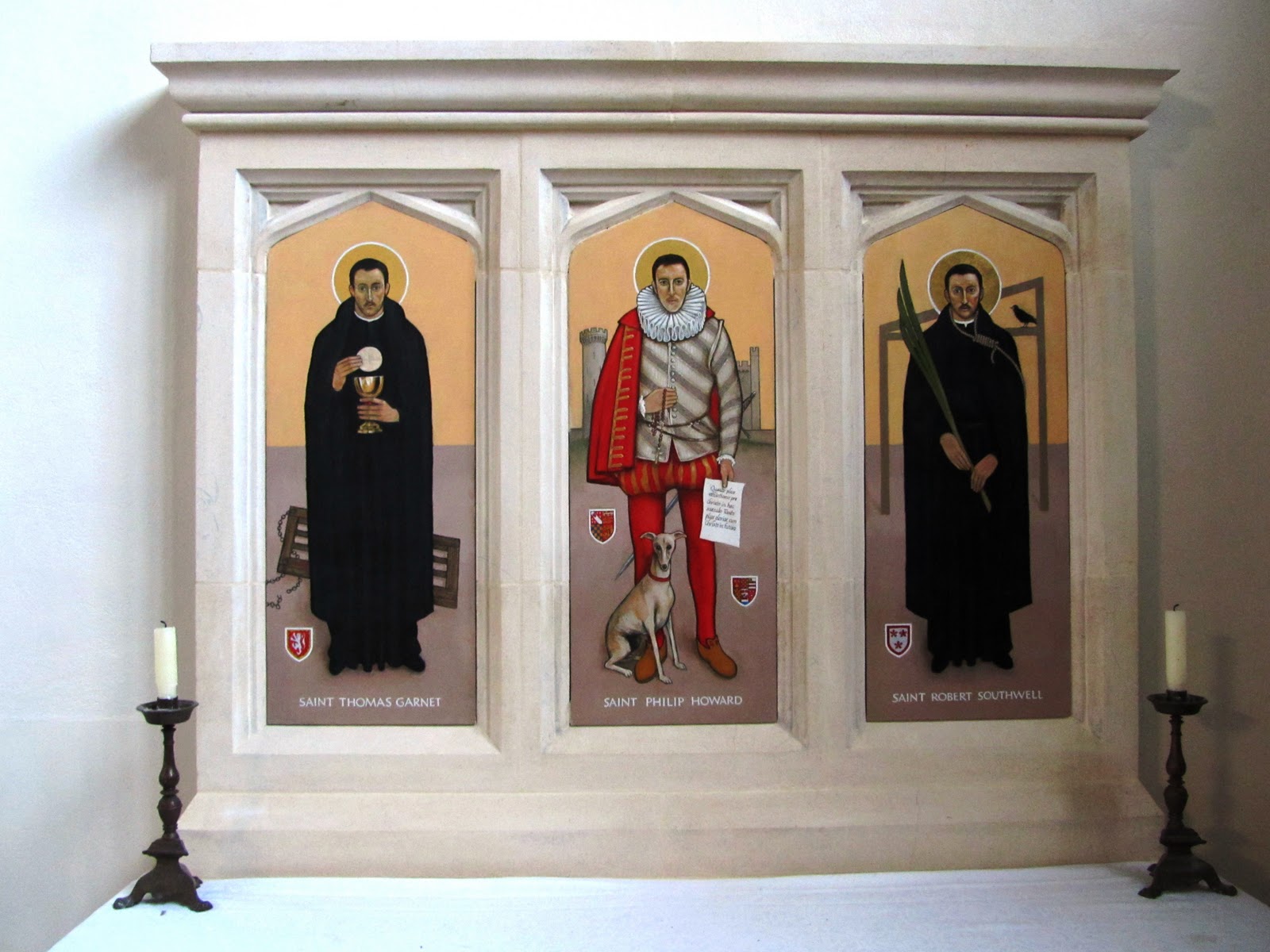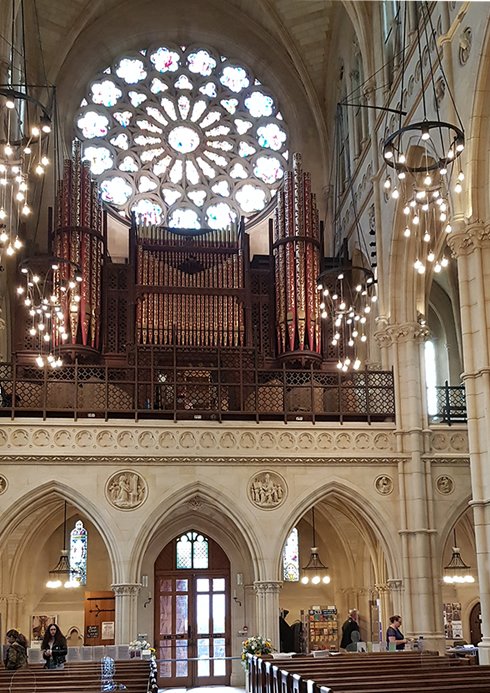
-Lord Arundel, age 18, by George Gower
Philip Howard (1557-1595), handsome, clever, rich – also impeccably aristocratic – seemed to unite some of the best blessings of existence. His conscience, however, and still more his wife, prevented his sinking into the abyss of privilege.
Born at Arundel House in the Strand, Philip was the only child of Thomas Howard, fourth Duke of Norfolk, and his wife Mary, daughter of the 12th Earl of Arundel. Philip of Spain, later King Philip II, became his godfather. He was baptized at Whitehall Palace with the royal family in attendance, and was named after his godfather, King Philip II of Spain. His home from the age of seven was a former Carthusian monastery.
Philip’s mother died shortly after his birth. His father, by his next wife, had two more sons and three daughters. Then, through a third match, to Elizabeth, widow of the 4th Baron Dacre, he acquired four stepchildren. In 1571 Philip was married at the age of fourteen to Anne, the eldest Dacre daughter, his step-sister. It was an arranged marriage, which Philip resented at first.
Widowed again in 1567, his father, the Duke of Norfolk, intrigued on behalf of Mary Queen of Scots, whom he hoped to marry. Instead, he was executed in 1572 and the dukedom lapsed.
Philip, after two years at St John’s College, Cambridge, took up residence at court in the hope of restoring his family to favor. His wife he left neglected in the country. His life had been a frivolous one, both at Cambridge and at Court.
Queen Elizabeth, however, never warmed to him, even though in 1578 Philip spent a fortune entertaining her at Kenninghall in Norfolk. His mother’s family, the Fitzalans, were far from impressed by his conduct. Nevertheless, in 1580 Philip succeeded his maternal grandfather as 13th Earl of Arundel.
He was present at the debate held in 1581 in the St John Chapel of the Tower of London, between Father Edmund Campion, a Jesuit, Father Ralph Sherwin and a group of Protestant theologians over Campion’s Decem Rationes. He was so impressed by the Catholics that he experienced a spiritual conversion. He renounced his previous, frivolous life and was reconciled with his wife.
Howard’s conversion influenced his behavior at Court and the change did not go unnoticed. Although he maintained his duties at Court and in Parliament, Howard did not go to any Anglican services. He had been one of the most spendthrift and gallant of Elizabeth’s courtiers, neglecting his wife; now Howard was solemn and devoted to Anne.
By 1585, it was a felony to aid a Catholic priest and an act of treason for an English Catholic priest to be in the country. Howard had a Catholic chaplain in his house in London and his castle at Arundel.
Another Jesuit missionary, Father William Weston, received Howard into the Catholic Church on September 30, 1584, three years after those debates in the Tower.
Unable to support the pains of recusancy, he determined to flee England and join recusants in Flanders. Anne, who was pregnant with his son, Thomas, would join him later. He would never see either of them again. Philip was a man of high profile, and his movements were closely watched by Queen Elizabeth’s spies. Arrested at sea, he was arraigned before the Star Chamber, and imprisoned in the Tower.
His father and grandfather (the poet, Henry, Earl of Surrey) had both been beheaded. Now Philip appeared to face the same fate.
In 1588 a Catholic priest called Fr William Bennet, imprisoned with him in the Tower, confessed under torture that Howard had instructed him to say Mass on behalf of the Spanish Armada. Bennet, however, later admitted he “confessed everything that seemed to content their humour”.
Howard was condemned to death, though the sentence was never carried out. Disdaining the offer of freedom should he return to the state religion, he passed his imprisonment in translating and writing spiritual works.
Queen Elizabeth never signed the death warrant, but Howard was not told this. He was kept constantly in fear of execution, although comforted by the companionship of a dog, which served as a go-between by which Howard and other prisoners, most notably the priest Robert Southwell, could send messages to each other. Although these two men never met, Howard’s dog helped them to deepen their friendship and exchange encouragement in each other’s plight. Philip Howard loved his pet, who is remembered along with him in a statue at Arundel Cathedral.
Howard spent ten years in the Tower, until his death from dysentery, was the official story. He petitioned the Queen as he lay dying to allow him to see his wife and his son, who had been born after his imprisonment. The Queen responded that “If he will but once attend the Protestant Service, he shall not only see his wife and children, but be restored to his honors and estates with every mark of my royal favor.” To this, Howard is supposed to have replied: “Tell Her Majesty if my religion be the cause for which I suffer, sorry I am that I have but one life to lose.” He remained in the Tower, never seeing his wife or daughter again, and died alone on Sunday 19 October 1595. He was immediately acclaimed as a Catholic (dry) Martyr.
He died on October 19 1595 after an illness of two months. Poisoning was suspected. “The more affliction we endure for Christ in this world,” ran the Latin inscription in his room, “the more glory we shall obtain with Christ in the next.”
His son Thomas (1586-1646) succeeded as Earl of Arundel. Philip Howard was canonized in 1970.

-martyrs chapel, Horsham, England, please click on the image for greater detail.

-organ at the Arundel Cathedral of Our Lady and Saint Philip Howard, Arundel, West Sussex, England
Love,
Matthew
